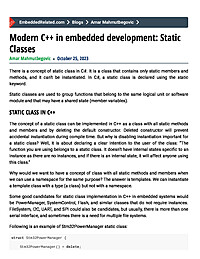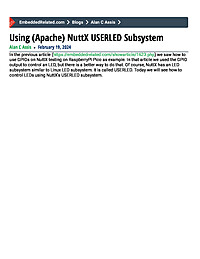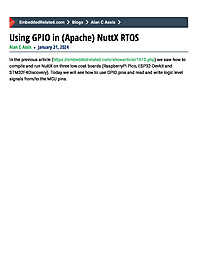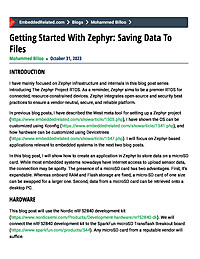
Getting Started With Zephyr: Saving Data To Files
In this blog post, I show how to implement a Zephyr application to mount a microSD card, create a new file on the microSD card, and write data to it. The lessons learned from such an application can be helpful for devices out in the field that need to write data to off-board memory periodically, especially in cases where Internet access may be sporadic.
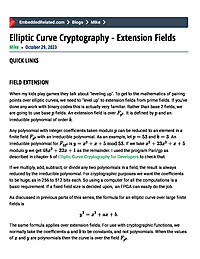
Elliptic Curve Cryptography - Extension Fields
An introduction to the pairing of points on elliptic curves. Point pairing normally requires curves over an extension field because the structure of an elliptic curve has two independent sets of points if it is large enough. The rules of pairings are described in a general way to show they can be useful for verification purposes.
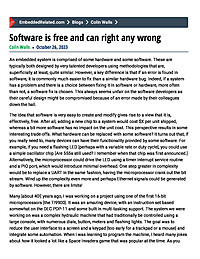
Software is free and can right any wrong
Software changes are so much easier than hardware modifications, so the temptation is always to take this approach to fixing bugs. This may not always be a good idea.
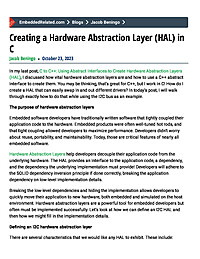
Creating a Hardware Abstraction Layer (HAL) in C
In my last post, C to C++: Using Abstract Interfaces to Create Hardware Abstraction Layers (HAL), I discussed how vital hardware abstraction layers are and how to use a C++ abstract interface to create them. You may be thinking, that’s great for C++, but I work in C! How do I create a HAL that can easily swap in and out different drivers? In today’s post, I will walk through exactly how to do that while using the I2C bus as an example.
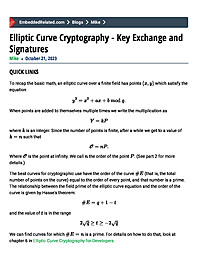
Elliptic Curve Cryptography - Key Exchange and Signatures
Elliptic curve mathematics over finite fields helps solve the problem of exchanging secret keys for encrypted messages as well as proving a specific person signed a particular document. This article goes over simple algorithms for key exchange and digital signature using elliptic curve mathematics. These methods are the essence of elliptic curve cryptography (ECC) used in applications such as SSH, TLS and HTTPS.
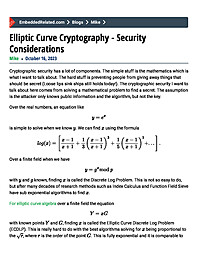
Elliptic Curve Cryptography - Security Considerations
The security of elliptic curve cryptography is determined by the elliptic curve discrete log problem. This article explains what that means. A comparison with real number logarithm and modular arithmetic gives context for why it is called a log problem.
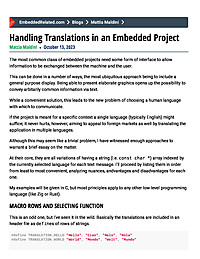
Handling Translations in an Embedded Project
A brief walkthrough on how to handle human language translations in a low level C application. Some options are listed, each with advantages and disadvantages laid out.

Elliptic Curve Cryptography - Basic Math
An introduction to the math of elliptic curves for cryptography. Covers the basic equations of points on an elliptic curve and the concept of point addition as well as multiplication.
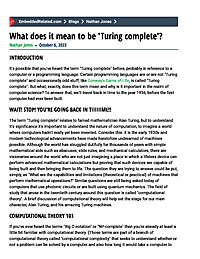
What does it mean to be 'Turing complete'?
The term "Turing complete" describes all computers and even some things we don't expect to be as powerful as a typical computer. In this article, I describe what it means and discuss the implications of Turing completeness on projects that need just a little more power, on alternative processor designs, and even security.

Getting Started With Zephyr: Saving Data To Files
In this blog post, I show how to implement a Zephyr application to mount a microSD card, create a new file on the microSD card, and write data to it. The lessons learned from such an application can be helpful for devices out in the field that need to write data to off-board memory periodically, especially in cases where Internet access may be sporadic.
Getting Started With Zephyr: Devicetree Bndings
This blog post shines some light on how devicetrees are used in The Zephyr Project. Specifically, we understand the mechanisms that enable us to use nodes in the devicetree in the C source files. We use a sample provided in the Zephyr repository itself and work our way through portions of the Zephyr codebase to get insight into the mechanisms that make this possible.
Getting Started With Zephyr: Kconfig
In this blog post, we briefly look at Kconfig, one of the core pieces of the Zephyr infrastructure. Kconfig allows embedded software developers to turn specific subsystems on or off within Zephyr efficiently and control their behavior. We also learn how we can practically use Kconfig to control the features of our application using the two most common mechanisms.
C to C++: 5 Tips for Refactoring C Code into C++
The article titled "Simple Tips to Refactor C Code into C++: Improve Embedded Development" provides essential guidance for embedded developers transitioning from C to C++. The series covers fundamental details necessary for a seamless transition and emphasizes utilizing C++ as a better C rather than diving into complex language features. The article introduces five practical tips for refactoring C code into C++. Replace #define with constexpr and const: Discouraging the use of #define macros, the article advocates for safer alternatives like constexpr and const to improve type safety, debugging, namespaces, and compile-time computation. Use Namespaces: Demonstrating the benefits of organizing code into separate logical groupings through namespaces, the article explains how namespaces help avoid naming conflicts and improve code readability. Replace C-style Pointers with Smart Pointers and References: Emphasizing the significance of avoiding raw pointers, the article suggests replacing them with C++ smart pointers (unique_ptr, shared_ptr, weak_ptr) and using references

Modern C++ in Embedded Development: (Don't Fear) The ++
While C is still the language of choice for embedded development, the adoption of C++ has grown steadily. Yet, reservations about dynamic memory allocation and fears of unnecessary code bloat have kept many in the C camp. This discourse aims to explore the intricacies of employing C++ in embedded systems, negotiating the issues of dynamic memory allocation, and exploiting the benefits of C++ offerings like std::array and constexpr. Moreover, it ventures into the details of the zero-overhead principle and the nuanced distinctions between C and C++. The takeaway? Armed with the right knowledge and a careful approach, C++ can indeed serve as a powerful, safer, and more efficient tool for embedded development.

Ten Little Algorithms, Part 1: Russian Peasant Multiplication
This blog needs some short posts to balance out the long ones, so I thought I’d cover some of the algorithms I’ve used over the years. Like the Euclidean algorithm and Extended Euclidean algorithm and Newton’s method —...
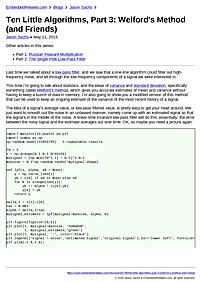
Ten Little Algorithms, Part 3: Welford's Method (and Friends)
Other articles in this series: Part 1: Russian Peasant Multiplication Part 2: The Single-Pole Low-Pass Filter Last time we talked about a low-pass filter, and we saw that a one-line algorithm could filter out high-frequency noise, and...





